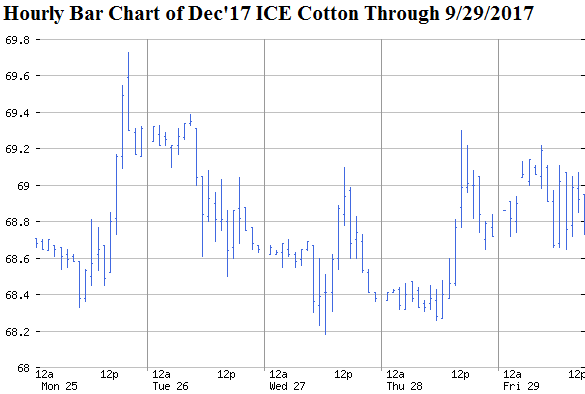
For the week ending September 29 the most active Dec’17 cotton contract peaked Monday with a technically-assisted penny gain on the day. The pattern through early Thursday appeared to be a gradual down-trend from there, until a rally/consolidation from mid-Thursday to Friday. Fundamental news this week included moderate export sales, and the onset of cooler, wetter “deer hunting weather” in northern Texas, Oklahoma, and Kansas. Dec’17 ICE cotton futures settled the week at 68.45 cents per pound, which is only one hundredth of a cent lower than where it settled the previous week. This also represents a continued narrowing inversion over Dec’18 cotton to 0.50 cents per pound on Friday. A sample of option prices on ICE cotton futures saw relatively small changes from the previous week. On Thursday, September 28, an in-the-money 73 put option on Dec’17 was worth 4.74 cents per pound, while a 73:66 put spread was worth 3.99 cents. Out-of-the-money 73 call options on Jul’18 ICE futures were worth 2.43 cents per pound on Thursday; a further out-of-the-money 79 call on Jul’18 traded for 1.13 cents. Looking ahead to next year’s crop, a near-the-money 67 put option on Dec’18 cotton cost 3.90 cents per pound on Thursday, while an out-of-the-money 60 put on Dec’18 cost 1.49 cents. Chinese and world cotton prices were mixed this week.
With the post-Hurricane Harvey rally, we may have seen the last opportunity for ICE futures over 70 cents for a while. There may, however, be a greater risk within six months to see futures under 60 cents. But since that is all uncertain, growers should remain poised and ready to take advantage of unexpected rallies, and protect themselves from sudden sell-offs. Forward contracting, immediate post-harvest contracting, and/or various options strategies can be used to limit downside risk while retaining upside potential. In particular, contracted bales could also be combined with call options on the deferred futures contracts. It is not too early to be evaluating the worth of put spread strategies to hedge the 2018 crop. Hedgers still with put or put spread positions on Dec’17 need an exit plan wince the remaining time value will erode exponentially in October.
Πηγή: The Cotton Marketing Planner
